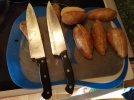David Martin
Moderator
- Joined
- Apr 7, 2008
- Messages
- 19,520
Is conical grind the same as a flat grind?
I'm asking this because I'm seeing this wording on knife descriptions from companies that traditionally do flat grinds. Thanks, DM
I'm asking this because I'm seeing this wording on knife descriptions from companies that traditionally do flat grinds. Thanks, DM
Last edited:








